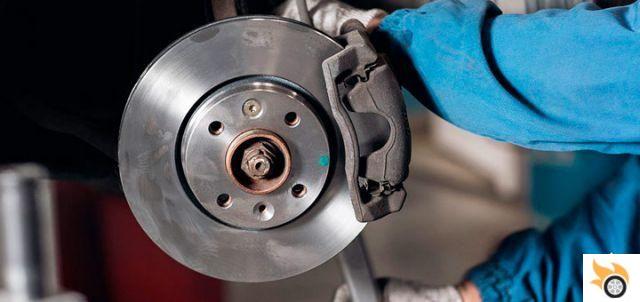
Welcome to Pistonudos.com, your trusted source for automotive information. In this article, we are going to explore the different types of car brakes, how they work, and the importance of the braking system in a car. We will also explain the components that are part of the braking system and how it works in general. Let's get started!
1. Types of car brakes
There are various types of brakes used in automobiles, each with their own characteristics and advantages. The most common are:
Disc brakes
Disc brakes are widely used on most modern vehicles. They consist of a metal disc that rotates along with the wheel, and a caliper that squeezes the brake pads against the disc to stop movement. These brakes offer excellent braking capacity and are more efficient in dissipating the heat generated during braking.
Drum brakes
Drum brakes are more common on older or smaller vehicles. They use a rotating drum that contains the brake pads inside. When braking force is applied, the pads expand toward the drum, creating friction and stopping movement. Although they are less efficient than disc brakes, they are cheaper and more durable.
regenerative brakes
Regenerative braking is a newer technology found in electric and hybrid vehicles. These brakes take advantage of the kinetic energy generated during braking to recharge the vehicle's battery. By slowing down, the electric motor acts as a generator and converts kinetic energy into electrical energy, which is stored in the battery for later use.
2. How car brakes work
The braking system of a car is essential to ensure driving safety. Next, we explain how car brakes work:
Hydraulic pressure
Most vehicles use a hydraulic brake system, which relies on fluid pressure to transmit braking force. When you step on the brake pedal, pressure is exerted on the brake fluid, which is transmitted through the lines to the calipers or brake cylinders. These components apply the necessary force to stop the wheels.
Friction
Friction is the fundamental principle in the operation of car brakes. Both disc and drum brakes use brake pads that create friction upon contact with the disc or drum. This friction converts the kinetic energy of the vehicle into heat, which slows and stops motion.
3. Importance of the braking system in a car
The braking system is one of the most important components of a car, as it guarantees the safety of both the driver and passengers and other road users. Some reasons why the braking system is crucial are:
safe stop
An efficient braking system allows the vehicle to stop safely and quickly, avoiding collisions and accidents. Proper stopping power is especially important in emergency situations, where every second counts.
Speed control
The braking system also makes it possible to control the speed of the vehicle. By gradually applying the brakes, you can slow down in a controlled manner, which is essential for adjusting to different road conditions and maintaining safe driving.
4. Brake system components and their operation
A car's braking system is made up of several components that work together to stop the vehicle. These are some of the most important components:
Brake pedal
The brake pedal is the point of contact between the driver and the braking system. Stepping on the pedal starts the braking process.
Brake fluid
Brake fluid is essential to transmit hydraulic pressure from the brake pedal to the wheels. It must be in good condition and have the appropriate level for optimal functioning of the braking system.
Brake calipers and cylinders
Brake calipers and brake cylinders are the components that apply braking force to the wheels. With disc brakes, the calipers push the pads against the disc, while with drum brakes, the cylinders push the pads toward the drum.
Brake pads and shoes
The pads and brake shoes are responsible for generating friction when they come into contact with the disc or drum. These components wear out over time and must be replaced periodically to maintain optimal braking system performance.
Frequently Asked Questions (FAQs)
1. What is the difference between disc brakes and drum brakes?
The main difference between disc brakes and drum brakes lies in their design and operation. Disc brakes offer better stopping power and heat dissipation, while drum brakes are more economical and durable. The choice between both types of brakes depends on the type of vehicle and the needs of the driver.
2. When should I replace the brake pads?
Brake pads should be replaced when they reach a safe minimum thickness. This varies by vehicle type and driving style, but it is generally recommended to replace pads when they are less than 3mm thick. It's also important to watch for any unusual noise or vibration under braking, as this can indicate excessive pad wear.
Conclusion
In short, car brakes are an essential component to ensure driving safety. Different types of brakes, such as disc brakes, drum brakes, and regenerative brakes, offer different advantages and suit different needs. The braking system, made up of several components, works using hydraulic pressure and friction to bring the vehicle to a safe and controlled stop. Remember to maintain proper brake system maintenance and replace worn components to ensure optimal performance. Drive safe!
We hope this article has been useful for you to understand the different types of car brakes, how they work and the importance of the braking system in a car. If you have any additional questions or want to share your experience, feel free to leave us a comment below. We would love to hear your opinion!
Until next time,
The Pistonudos.com team


























